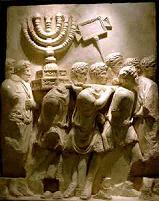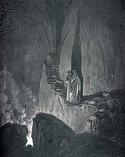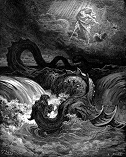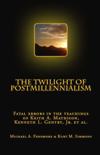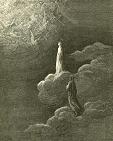Identifying Gog & Magog
The Great Battle of the End Times
By Kurt M. Simmons
Introduction
Revelation twenty is among the most difficult
passages in the Bible. Whole interpretative schools have grown
up with names describing their particular approach to the chapter.
Amillennialism, Premillennialism, and Postmillennialism describe
these schools’ particular interpretation of Revelation’s millennia.
Although disagreement exists concerning the nature and timing of the
millennia, all agree that the battle of Gog and Magog immediately
precedes Christ’s eschatological coming in judgment upon world.
If Preterists are to succeed in convincing others that Revelation is
fulfilled, then they must have a firm command on the battle of Gog
and Magog and be able to convincingly identify its historical
referent. In this article, we will show that Gog and Magog was
a symbol employed for the persecution under Nero and the Jews.
Old Testament Themes and the Prophetic Method
It will be helpful to our understanding of
Revelation if we first survey the source of John’s imagery and gain
an understanding of the themes and method of the Old Testament
prophets. The three major themes of the OT prophets were 1)
the coming judgment upon
In this example, the first part of the prophecy
appears to have Zerubbabel in view. In its immediate historical
context, Zerubbabel was the “one head” that would lead the captivity
out of Assyrio-Babylonian captivity. However, the prophecy has
a plenior sensus (Lat. “fuller sense”), and looks
beyond the return of the captivity unto Christ (“David their king”).
As Zerubbabel gathered the captivity home to the
This prophecy is especially poignant because it
inserts a prophecy of the restoration of the Davidic throne in
Christ (“the tabernacle of David”) in between prophecies of the
coming captivity (“sifting Israel among the nations”) and the
restoration of Israel to its land (“I will bring again the captivity
of my people”). We know that the raising up of the tabernacle
of David looked ahead to Christ because we have James’s inspired
word for it in the book of Acts. (Acts
The Return of the Captivity and Coming of Christ
In the Book of Ezekiel
The imagery of Gog and Magog in Revelation is
adapted from Ezekiel. Like other prophets, Ezekiel wrote about
the coming captivity, the restoration to the land, and the coming
kingdom of the Messiah. The first half of Ezekiel addresses
the coming captivity and is laden with prophecies of wrath and
lamentation; the latter half is devoted to the themes of national
restoration and the coming of Christ. Ezekiel’s most graphic
portrayal of the return of the captivity is set out in his prophecy
of the “valley of dry bones” (Ezek. 37:1-17): The nation was
in captivity; the ten northern tribes carried away by the Assyrians;
The prophecy of the dry bones would be
fulfilled in the restoration of
Like Hosea’s prophecy of “David their king,”
David here is a symbol for Christ and speaks to the restoration of
the Davidic throne that had been usurped by Nebuchadnezzar and the
Gentile powers. However, Christ would not sit upon the throne
of David on earth or the terrestrial
Peter makes plain that the prophecies of “David
their king” spoke to the resurrection of Christ and his coronation
in the heavenly
Ezekiel’s prophecies of the valley of dry bones
and “David my servant” occur in Ezekiel thirty-seven; the prophecy
of Gog and Magog occurs in chapters thirty-eight and thirty-nine.
Thus, restored
The Eschatological
Ezekiel describes the great battle of the end
time in terms of a pagan hoard that invades the
Several points need to be made at this
juncture. First, Gog has set himself as the enemy of God and
his people and there is an historical account that the Lord wants to
settle. When he says that “after many days thou shalt be
visited,” the prophet indicates that God has abstained from
vengeance for many years, but that Gog’s day would come.
Gog’s war against restored

Having established the time of Gog’s attack and
the extent of his territory, it remains only to show whom he
attacked. Ezekiel describes the objects of Gog’s invasion as
those “brought forth out of the nations;” viz., restored
Israel under “David,” which is to say, the church. But
if Gog’s territory answers to the Roman empire, and the time of his
attack upon the church preceded the destruction of Jerusalem, then
what historical event must the prophet have in mind? That’s
right, the great spiritual battle that overtook the church in the
first century. The battle of Gog and Magog is a symbol of the
eschatological persecution of the saints by Nero and the Jews.
This conclusion is corroborated by John’s Revelation.
Gog and Magog in Revelation
In Revelation, the battle of Gog and Magog
occurs after the defeat and symbolic thousand-year binding of the
dragon in the bottomless pit. The dragon represents the
embodiment of sin and death expressing themselves in the children of
disobedience in the form of Leviathan, the world civil power at
enmity with God and his people. The dragon first appears in
Rev. 12, where he attempts to kill the Christ-child in Herod’s
slaughter of the innocents. (Rev. 12:4; Matt. 2:16-18)
The child escapes and is later caught up to the throne of God.
However, he first wages war with the dragon and his angels under the
guise of Michael the Archangel (prince of angels). This was the
earthly ministry of Christ, who defeated the power of sin and death
by the blood of his cross (Rev. 12:11; Col. 2:14, 15), wresting the
right of world dominion from dragon. Ascending to heaven, it thus
became Christ’s to rule all nations with a rod of iron. (Rev.
12:5)
When the dragon saw that he was defeated, he
made war against the woman who bore the Christ child: not Mary, but
the virgin of Zion, the mother church in Palestine. (Rev.
12:13) Following as it does upon the heels of Christ’s
ascension, this persecution is easily identified as the persecution
that arose over Stephen, which St. Paul led under the commission of
the Sanhedrin with the assent of Pilate. The dragon did not
wage this persecution directly, but through its alter ego (Lat.,
other I) the “beast.” (Rev. 11:7) The beast is
the persecuting power of the civil government; it receives authority
to wage war against the saints from the dragon (imperial Rome).
(Rev. 13:2, 4) The persecution that arose over Stephen lasted
three and a half years, or one thousand two hundred and sixty days
(A.D. 34-38) (Rev.12:6, 14); it collapsed with the removal of
Caiaphas from the high priesthood; Pilate’s leaving Judaea, and the
conversion of St. Paul. The persecution revived momentarily
under Herod Argippa I (Acts 12 - circa A.D. 41), but ended
almost as abruptly as it started when Agrippa died of a stroke from
God. Aggrippa II was too young to manage his father's
kingdom, so Claudius returned Judea to a province and sent thither
Cuspius Fadus as procurator, returning the protection of law to the
church. The collapse of the persecution in Palestine is
represented by the earth opening its mouth to swallow the flood of
persecution pouring out of the dragon’s mouth. (Rev. 12:16)
It is also symbolized by the beast receiving a mortal wound to one
of its heads. (Rev. 13:3)
In receiving the mortal wound to its head, the
beast lost the power to persecute and symbolically went down in
death to the bottomless pit (hades tartarus). (Rev.
11:7; 17:8) The dragon, which gave the beast power, also went
down to the bottomless pit. (Rev. 20:1, 2) Both the
dragon and beast remained in the bottomless pit for a period
symbolized by a thousand years. (Rev. 11:7; 17:8; 20:7)
Greco-Roman notions of hades had it that the dead lived in hades a
thousand years, after which they were born anew into earthly life.
(Plato, Republic, Bk. X, 315-320; Virgil, Aeneid,
Bk. VI, 734-769; Justin Martyr, 1st Apology,
VIII, Ante-Nicene Fathers, p. 165) The scriptures speak of the
spiritual realm in similar terms, as essentially timeless, where a
thousand years is as a day, and vice versa. (Ps. 90:4;
II Pet. 3:8) This seems to be the significance of the thousand
year internment of the dragon and beast; it points to the period
during which they were “dead” in terms of their power to persecute
the church.
Claudius was the “angel” that bound the dragon. (Rev. 20:1) All during Claudius’ reign the church enjoyed the protection of law; even banishing Jews from Rome for rioting against the church. (Acts 18:2) St. Paul alludes to Claudius in his second epistle to the Thessalonians as “he who lets” (restrains). (II Thess. 2:6, 7) The persecution of the last day would not come so long as Claudius was upon the throne, repressing the mystery of iniquity and powers of persecution. When Claudius was taken out of the way, Nero would be revealed as the man of sin and son of perdition, and the church would be gathered in martyrdom unto Christ. John portrays this by the dragon and beast being loosed from the bottomless pit and the mortal wound to the beast’s head having healed. John described the beast in Rev. 17:8 as the beast that “was and is not and is about to ascend out of the bottomless pit.” That is, the persecuting power of the empire that suffered defeat by the collapse of the persecution over St. Stephen was about to manifest itself again, this time under Nero, whose name the beast bore. This is the point at which the battle of Gog and Magog begins:
And when the thousand years are expired, Satan shall be loosed out of his prison, and shall go out to deceive the nations which are in the four quarters of the earth, Gog and Magog, to gather them together to battle: the number of whom is as the sand of the sea. Rev. 20:7
“Satan” is a generic term signifying an
adversary. The character which here in verse seven is
called “satan” in verse two is called the “dragon.” In other
words, the adversary in this case was world civil power embodied in
Rome, Nero, and the Jews. In Rome, the beast was identified
with Nero, who was its driving power (Rev. 13:1-10); in Asia and
other parts of the empire, the Jews, at the behest of their leaders
in Jerusalem, were the driving force. John portrays this by a
harlot, riding the beast in a surfeit of blood and gore. (Rev.
17:3-6) In Palestine, the persecution was driven by the “false
prophet,” the religious leaders of the Jews who bade them to make an
inquisition against the church like unto the beast’s. (Rev.
13:11-18) The dragon and beast make war against the church by
surrounding the “camp of the saints” (the church). But fire
comes down from God out of heaven and consumes Gog and his host, and
the dragon, beast, and false prophet are cast into the lake of fire.
(Rev. 19:20, 21; 20:9, 10) The harlot is also consumed.
(Rev. 18) An angel calls to the birds of heaven to come and
devour the carcasses of the slain. (Rev. 19:17, 18) This
is a direct quote from Ezekiel. (Ezek. 39:17)
John's application of Ezekiel's prophecy is certain proof that the
persecution under the dragon, beast, false prophet and harlot were
the battle of Gog and Magog. Their destruction occurred in the
cataclysmic events of the first century, including famines,
earthquakes, and plagues, in which also Rome saw a succession of
civil wars and four emperors in the space of little more than a
year, and Jerusalem was destroyed by Titus. Following the
world-wide devastations of the last days, God renewed the earth, in
which the church reigns supreme with Christ. (Rev. 21, 22)
Conclusion
The battle of Gog and Magog was a symbol for the eschatological battle of the last days; the persecution under Nero and the Jews.
To receive Kurt Simmons’ e-mail newsletter, The Sword & The Plow, click the Subscribe link:
All rights reserved.
